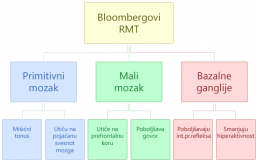Bloomberg RMT
Bloomberg rhythmic movements have an identical effect on the brain as spontaneous rhythmic movements of an infant.
THE PRIMITIVE BRAIN
If for some reason there is a reduction in the stimulation of the primitive brain by vestibular, kinesthetic and tactile information – this will be the result of reduced muscle tone in the extensor muscles of the body.
This is the reason why it is extremely important for the baby to be patted, carried, rocked and allowed to move freely.

CEREBELLUM AND RHYTHMIC MOVEMENTS
The cerebellum has strong connections with the vestibular and other cores found in the primitive brain, responsible for coordinating movements. On the other hand, it also has extremely strong connections with the basal ganglia and the motor cortex of the cerebrum.
These connections are the BASE for the development of coordinated motor activity, making movements easy, as well as recognizing errors during execution and correcting them. In the period from the 6th to the 12th month of a child’s life, the cerebellum grows significantly. Rhythmic movements affect the development of cerebellar neural networks and its connections with other structures.
CEREBELLAR DYSFUNCTION INFLUENCES ATTENTION AND LEARNING DIFFICULTIES
Some children find it extremely difficult to perform simple rhythmic coordinated movements.
The dysfunction of the cerebellum leads to the dysfunction of other regions of the cerebrum, especially the prefrontal cortex and speech regions in the left half of the brain. This can be manifested as attention disorder, affecting also planning, reasoning, control of impulse reactions, as well as abstract thinking. It can also affect spontaneous eye movements, reading, information processing speed, memory, learning and speech.
- Connections with the prefrontal cortex – ffect attention, planning, reasoning, control of impulse reactions
- Connections with the speech regions, Wernicke and Broca’s regions – which influence the development of speech
- Connections with the frontal regions of the brain are responsible for eye movements – they affect tracking and therefore reading!!!!
BASAL GANGLIA FUNCTION
Through evolution, this part of the human brain has had a significant influence on motor activity and is in close cooperation with the motor cortex, but it is also important for the function and control of social interactions characterized by rituals, routines, and strict hierarchical relationships.
The role of the basal ganglia:
- NHIBIT PRIMITIVE REFLEXES (spontaneous rhythmic movements of the baby) and INTEGRATE THEM into higher motor movement patterns
- CONTROL POSTURAL REFLEXES (balance, stability, influence of gravitational force – developed by spontaneous rhythmic movements)
- AUTOMATION OF MOVEMENTS that have been learned (feeding, riding a bicycle, driving a car…)
- REGULATE OUR ACTIVITY LEVEL and allow us to sit still! When we sit quietly focused on a given task, the basal ganglia are fully active